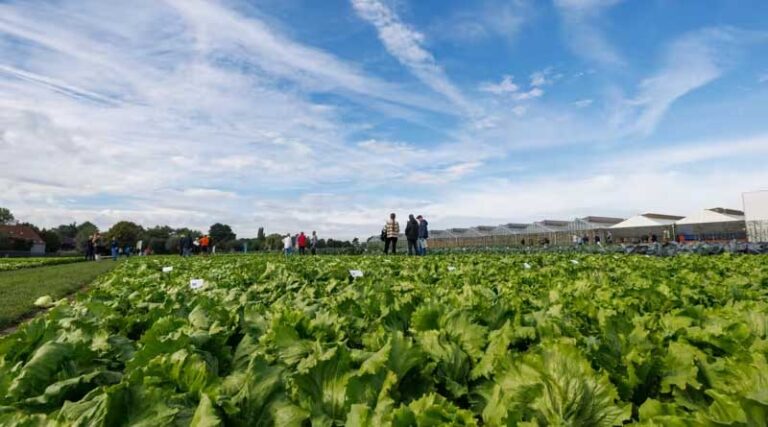
Low-Nitrogen Lettuce Production
29 September 2025, Netherlands: Is it possible to grow lettuce with significantly lower levels of nitrogen? Eight years ago, Lettuce Breeder Wim van Vliet decided to test whether the lettuce plants in the Rijk Zwaan breeding fields could cope with less fertiliser.
In the years since then, the plants in his selection fields have been receiving less nitrogen than the industry standard. “Tighter restrictions on the use of nitrogen, and higher fertiliser costs – these are things that Rijk Zwaan needs to anticipate. We want to be able to supply growers with varieties that are aligned with changing requirements,” says Wim.
Many parts of Europe are struggling with nitrogen pollution. Nitrogen compounds such as nitrogen oxides and ammonia – emitted by traffic, manufacturing and farming – end up in the soil, water and air. High nitrate levels in the soil can result in the emission of nitrous oxide, which is a potent greenhouse gas. Moreover, any nutrients – such as nitrate – that are not taken up by plants seep into the groundwater and surface water. This is particularly common in lettuce fields, with their light soil. If too much nitrate gets into the water, this can negatively impact on biodiversity and poses a threat to the quality of drinking water. Therefore, reducing nutrient losses in agriculture is an important part of the rules drawn up by the European Commission to protect biodiversity and improve air and water quality.
Interest from growers
“It’s essential that we reduce the use of nitrogen in horticulture,” comments Wim van Vliet, Lettuce Breeder at Rijk Zwaan. “Problems will arise in the next few years, either due to regulations to improve biodiversity and the health of soil, water and air, or because of high costs. After all, fertiliser is expensive – not least because of the increased price of the fuel needed to produce it.”
He has noticed significant interest from growers. “They are keen to cut back on fertilisers. Any nutrition that you don’t have to add is a saving. A large German lettuce-growing company visited our trials last year and is now experimenting with reducing its fertiliser usage. And various other growers are pushing the boundaries of what’s possible.”
No compromise on strength
It takes time to breed adapted varieties, such as lettuces that still grow well with less nitrogen. By anticipating such trends in good time, Rijk Zwaan starts developing suitable varieties before they are really necessary. “Rijk Zwaan’s iceberg lettuces are robust varieties that can withstand tougher conditions. We’re also running reduced-irrigation trials, for example. My goal is to make varieties that can be grown with less water and nutrition, without compromising on strength.”
Delaying fertiliser application
“Lettuce growers typically apply nitrogen twice a season: once before sowing, and again when hoeing. We always start by measuring how much nitrogen the soil has at the beginning, and how long the plants can grow in it.”
The amount of nitrogen varies. The ground in sandy soils often contains no nitrogen at all by the end of the winter, whereas sulphuric soils – which are richer in clay – can sometimes still have some nitrogen reserves at the start of the next growing season. “For the past few years in our selection fields, we have waited a while before adding fertiliser at hoeing time. We monitor how long the nitrogen level remains adequate, including in sandy soils. We can observe the plants for longer than growers can. We keep them in the field for a long time because we want to monitor their quality and strength. In some fields, we’ve seen lettuce plants grow trouble-free without us applying extra fertiliser – and there was still some nitrogen left in the ground at the end of the crop.”
New varieties require less nutrition
In other words, it is possible to grow lettuce with less nitrogen. In fact, all the lettuce varieties selected by Wim in recent years have been grown with much less nitrogen than the industry standard. “We’ve been working on this for eight years, and it only takes around six years to develop a new lettuce variety. So you could say that all our new iceberg lettuce varieties can actually cope with less nitrogen than is generally advised,” Wim states.
Giving guarantees
“We want to be able to give guarantees, of course. It would be nice to say to growers ‘You can grow this particular variety with this many kilos less nitrogen’, for instance.” That is difficult at the moment due to so many variations between seasons, countries, soil types and even fields. That’s why Rijk Zwaan started expanding its trials a year ago – not only at its trial fields in Fijnaart, the Netherlands, but also at Rijk Zwaan Welver in Germany and at Rijk Zwaan Ibérica in Spain, plus at growers’ premises. “With broader trials and more data, we can quantify how much less nitrogen our varieties need,” he concludes.
Also Read: Coffee Board Opens Draft Sustainability Standards for Indian Coffee to Stakeholder Feedback
📢 If You’re in Agriculture, Make Sure the Right People Hear Your Story.
From product launches to strategic announcements, Global Agriculture offers unmatched visibility across international agri-business markets. Connect with us at pr@global-agriculture.com to explore editorial and advertising opportunities that reach the right audience, worldwide.






